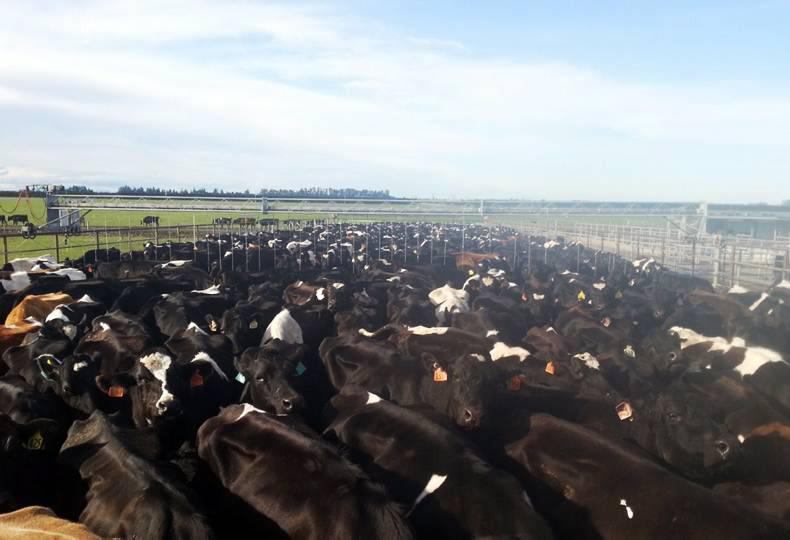We are currently milking 1,230 cows into the bulk tank, producing around 30,000 litres daily. The cows are producing 2.24kg milk solids per cow per day and SCC is around 170,000.
We are running two big milking herds. The first herd is around the 700-cow mark and the other herd has 530 cows. We also have a group of cows that require special care. These cows include colostrum cows, cows on antibiotics (nicknamed pennies because they are on penicillin) and lame cows. This mob has around 60 animals.
We were running three large herds but reduced it back to two as it is more labour-efficient. It means one less group to bring in and it keeps an extra person doing more milking or other work, instead of bringing in and out cows at a busy time of year.
The weather is warming up and ground temperatures are rising so grass is growing well. We are 90% finished our first round and silage pits have been empty since the end of last week. We are feeding palm kernel, maize and fodder beet to the milkers. We will be finished feeding supplement in 10 days as grass growth here moves quicker than at home, so it will be a grass-only diet very soon.
The aim is to produce 2.3kg of milk solids per cow for October. Until now we have been following cows with 36kg of nitrogen per hectare once they are finished grazing paddocks. Last week we sprayed off a 14ha paddock for a crop of beet to be grown on the farm.
Utilisation rates of beet is much higher than anything else we can offer in the paddock and the energy levels per kilo of dry matter makes it the most cost-effective feed source we can access. It will be ready to graze in May and still in good condition for grazing by late September.
Breeding
As calving is winding down with around 60 left to calve, our focus turns to breeding.
We are doing our pre-breeding heat detection using tail paint this week on all cows calved, as we are four weeks out from the start of breeding. We are also using Metricheck to assess uterine tract and see whether any animals will need treatment. We have ordered 1,800 straws, which breaks down to 1.2 straws per cow. The plan is to do four to six weeks of AI and then have a team of 30 Friesian cross and Jersey bulls to mop up.
In terms of heifer breeding, the programme we have implemented lasts 13 days. From the mating start date, they get a first shot of PG, then 13 days later they get a second shot of PG and on day 14 AI will start. They will use Kamars for heat detection and heifers will start a week ahead of the cows so labour can concentrate on the heifers for that period of time.
Cost cutting triggers changes on the farm
Last year the farm ordered and used 2,200 straws, so there is a big drop, but some of this is influenced by a lower stocking rate this year.
Staff numbers are down to keep the wage bill low. There are pros and cons to this. On the plus side, the staff learn how to work more efficiently on a large scale and teamwork becomes more important, along with good communication. However, with different nationalities, this can be difficult.
The negatives are that tiredness kicks in earlier, as more hours are being worked per man. This has an impact on decision making. It also causes a problem when existing staff are on days off or are out sick, especially when things go wrong. For example, sick calves or a downer cow requires the help of two people. The main lesson I learned here was to interpret a situation faster and ask for help sooner rather than later.
On calf rearing, we only fed milk, pea straw and lucerne bales with no meal. This saved NZ$20,000 this year and calves are doing extremely well.
More cows have been culled as prices are good, but not all cows were culled by choice as accidents happen on the farm and cows get sick – lame, mastitis, etc.
Fertiliser rates will drop this year to save some money. As the stocking rate is lower, nitrogen can drop. Hopefully, we will not make as many bales on grazing block and we can utilise more grass grown, instead of making silage. No bale silage was used last year as all-pit silage was made instead, which saved a lot of money. Individual wrapping of bales may be convenient but it comes at a cost and the farm decided it could not afford it 12 months ago.
Any dairy farmer should visit New Zealand
My time here has shown me how adaptable farmers must be to survive the current price drop. I learned that you must be able to make a ruthless decision, whether it comes to livestock or survival of your business to stay afloat.
Irish farmers can still learn a lot from our New Zealand counterparts, especially on efficiency and how to survive.
I would recommend anyone interested in dairy farming to come here for a calving season or a year. It will teach you a lot about dairying and give you new ideas to bring back to the home farm in Ireland.






 This is a subscriber-only article
This is a subscriber-only article












SHARING OPTIONS: